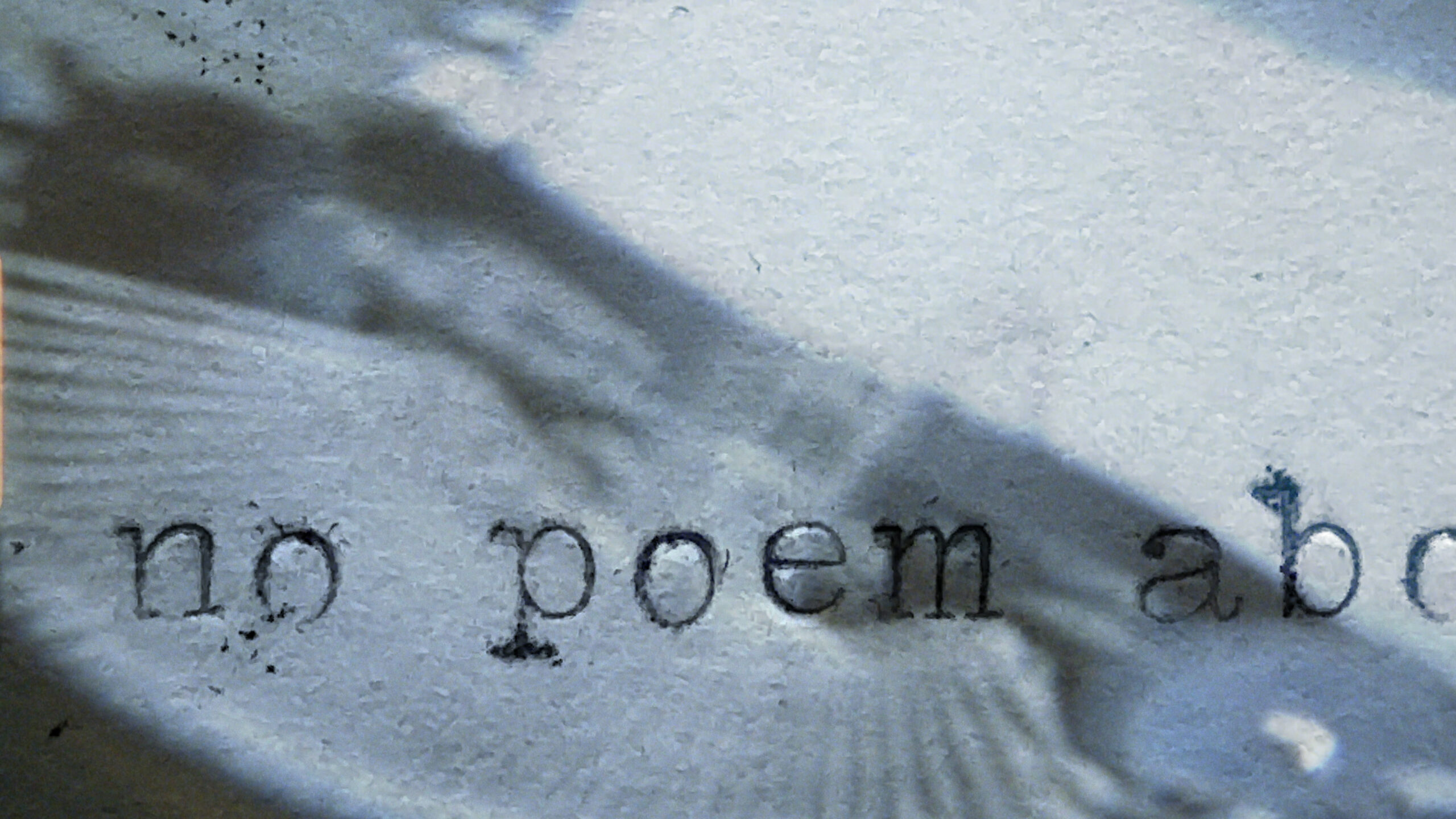
No Poem Animation
Elegiac as well as strangely hopeful, director Catherine Gund’s docu-poem, MEANWHILE, which premiered last year, has been one of the only things in recent memory that I have found soothing about the nature of humanity and the future of the world.
In close collaboration with Jacqueline Woodson (text), Meshell Ndegeocello (soundscape), Erika Dilday (support), and M Trevino (structure), Gund made a living – breathing – film that captures quiet, reflective moments from six artists in NYC as they continue with their lives and work throughout the many crises faced worldwide 2020-2021.
The themes evoked in MEANWHILE – survival, life, empathy, resilience, identity – feel even more relevant and urgent in 2025. By the time I saw the film this spring, the first planes of kidnapped immigrants had landed in El Salvador, a good friend at the Institute of Peace had called me to tearfully recount being physically removed from her workplace, and the United States seemed then as it does now to be marching with horrific determination toward authoritarianism.
Where do art and artists fit in during times of crisis? The conviction that art should or even can make meaning from and has potential to impact minor and major events, essentially that art matters – evident in the making of MEANWHILE – is as instinctual and vital as breath itself. “I believe there’s no way to survive without art,” Gund says, and what’s so moving in MEANWHILE is that without preaching or platitudes or predictions based in false hope or the end of the world, are messages about what art has to do with living and staying alive, and creates a humanistic portrait of how to face struggle with both softness and grit.
Catherine Gund as Interviewed by Rachel Dalamangas
The title MEANWHILE is evocative of time both on the scale of history as well as human life, and even the fleetingly momentary. The word is also suggestive of simultaneous action, and at various times throughout the film is associated with poetic themes of respite, freedom, and breath. When and over what period of time was this film shot? How did the word ‘meanwhile’ shape your approach to storytelling?
The title MEANWHILE was the beginning — it came before the film itself. That word held space for what we couldn’t yet articulate. We were living in a moment where the future had no language. In the face of the pandemic, the uprisings, the collapsing of systems that were never built for everyone, we were suspended in a kind of breath. MEANWHILE gave us a way to speak, poetically, politically. It holds multiplicity: the passing moment, the lifetime, the historic scale. It reminds us that while one story is unfolding, another is too — parallel lives, joys, violences, resistances, all breathing side by side. And never all joy or all violence.
If we’re always in a state of tension and chaos, and that energy is always moving, maybe the problem is that I’ve tried to stay still inside of it.
Is there a way to do things differently or to imagine
differently or practice living differently?
I don’t know that the natural condition of life is a state ofrelief.
Natalie Diaz
The film was shot over the course of 2020 and 2021 — those ruptured, reshaped years — but it wasn’t a linear shoot. It moved like breath, in and out, across time and tone. That rhythm shaped the structure: six verses, each a different facet of how we live, how we resist, how we care for each other. Some days were cinema verité, some days were poetry. Some moments were built on rage, others on care. We weren’t documenting a crisis — we were existing through it and creating from within it.
The word meanwhile grounded us. It reminded us that every image, every voice, is in conversation with something larger — with the past that made this present, and the future we’re still fighting to imagine. This isn’t escapism. It’s simultaneity — a way of being present to contradiction, to multiplicity, to all that breathes at once. Even in grief, there’s beauty. Even in stillness, there’s movement. MEANWHILE is a refusal to flatten the moment into one narrative. It’s a way to hold complexity — to breathe inside it.
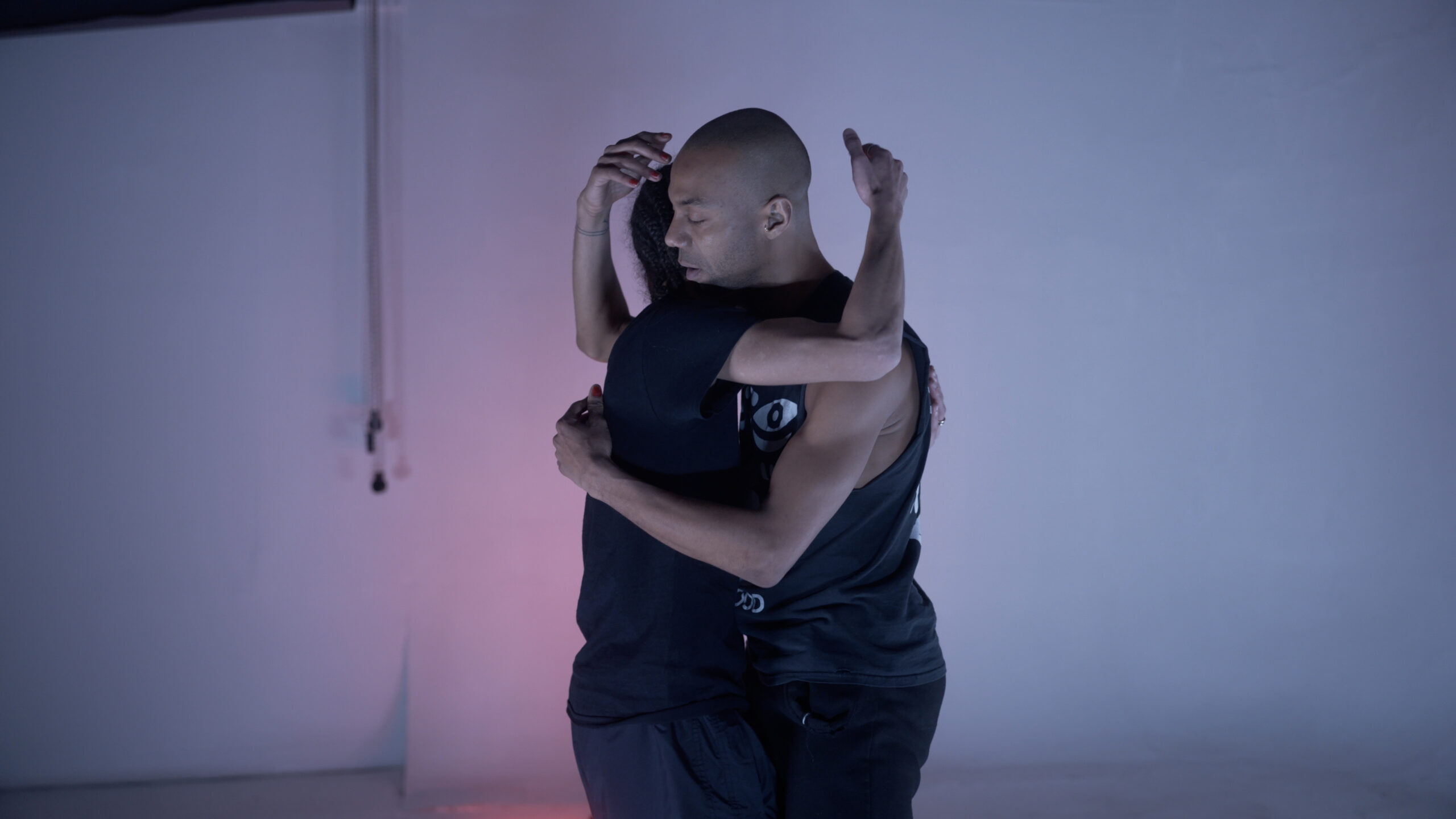
Shamel Pitts and Tushrik Fredericks
The film is formatted as a docu-poem in six parts. Did the author Jacqueline Woodson write the poem first and then the film was made, or was the film in progress and she responded to the footage?
Like the meanwhile, our film reveals synchronicity and simultaneity. We breathe to remember. We breathe to forget. The film began with Meshell Ndegeocello and me wanting to work together — to meld our associative, emotional, presence practices. Her sounds didn’t score the film; they scored the silence, the urge, the becoming. They created a space I could move inside. From those early pulses — breath and distortion, longing and loop — the film began to shape itself. Not in outline. In feeling. In time.
There was no sequence to our making. It wasn’t image, then music, then words. We were all inside the same storm. Meshell would send a sound, and I’d hold it up to the light of the footage. Jacqueline would listen, then speak a line:
“Like the newborn baby
who hasn’t yet heard the sound of her own cry,
we know, without the tears, that we’re alive.
We know long before we feel the pain of the outside world
that we are whole.
The fight already in our breath,
the fight in our hearts.”
Those words would ripple back to the edit, bend the image, slow the cut. We are born into interruption. Everything was responsive. We weren’t documenting — we were composing a present tense. Existing alongside.
The film unfolds in six verses. Not chapters. Not acts. Verses — because poetry was the only structure that could hold us, could breathe with us. Jacqueline didn’t write about the film; she wrote inside it. Her words were not commentary. They were blood and breath. Sometimes I would send her images pulled from her language. Other times, in the middle of this breath, this heartbeat, this fire, I would cut a scene just to leave space for a line to land:
“Even in the fire, we can’t extricate ourselves.
We’re all connected. Ancestors, aunts, uncles, children.
The blood that moves through our veins sings the same song —
a song we can pretend we don’t hear,
a song an inch away from our ears,
a song being sung always in the meanwhile.”
Everyone who appears in the film also creates from their own fire, their own heart, in an exchange that reverberates. We were finding a place where everyone’s path touches another — or doesn’t pass at all, but lingers nearby. In rehearsal, dancer Shamel Pitts says:
“There’s still this heat between us,
the sense of touch without touching,
and the heat that comes between this, from this —
and that we keep that alive.”
We weren’t illustrating a thesis. We were living a practice — of listening, of responding, of being changed by the work and each other. Nothing was finished until everything was. And even now, I don’t think of the film as complete. It’s still pulsing. Still saying:
“And we keep on keeping on
in all the ways, in always,
in all the spaces of time —
including in the meanwhile.
Meanwhile, we live.”
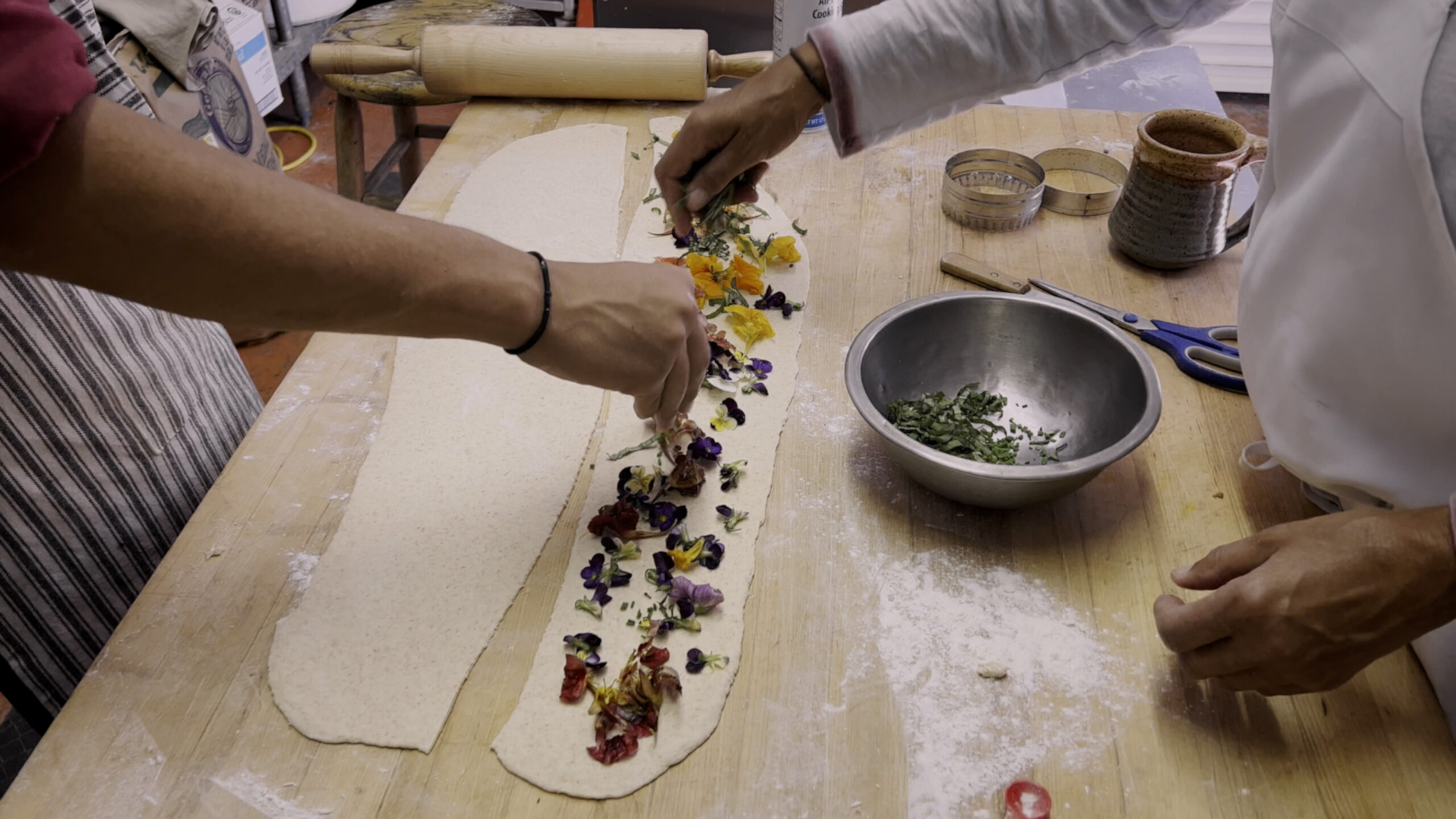
Juli Vanderhoop baking
The theme of breath is relevant both in the form of projective verse poetry as well as politically to the BLM movement, which adopted the last words of Eric Garner as slogan. Was this an intentional motif or one that arose organically through the process of making the film?
Breath was never a motif. It is the medium. Breathing is the pulse of the film, the rhythm that sustains and connects every frame.
This understanding didn’t begin as an intellectual choice — it emerged as a force, moving through us, through the footage, through the sound, through the words. Breath is political. It always has been. It’s the first act of life and the last. It’s the rhythm of survival — the breath that sustains, that resists, that says: I am still here, even in the face of forces that would seek to silence us.
In MEANWHILE, breath is the connective tissue — between image, sound, and word. It was the anchor of the time we were living in: the pandemic, where breathing became dangerous, measured, protected by machines; and the uprisings, where breath was denied. When Eric Garner said “I can’t breathe”, those words became a collective reckoning. We didn’t set out to make a film about breath, but breath insisted on being seen, heard, and felt. It rose up in Meshell’s looping, gasping, panting soundscapes; in Jacqueline’s verses, which returned, again and again, to one essential instruction: Breathe.
Breath is intimate. It’s ancestral. It’s violent. It’s liberating. We hear panting, inhaling, gasping, exhaling. We hear people breathing throughout the film. And the film breathes – expands and contracts, grips and releases – following the tension of our lives. Then quiet. This is the rhythm of the film’s structure – our fight to move through grief, through rage, through hope.
The film is about living in that tension. We breathe to remember. We breathe to forget. Breath is not just metaphor — it’s a condition of resistance and resilience. A refusal to be erased. A way of holding space for the past and the possible. It is the heartbeat of MEANWHILE, beating in rhythm with the ongoing fight for racial justice, for lasting freedom.
When Jacqueline says, “The fight already in our breath, the fight in our hearts,” she isn’t just talking about survival. She’s invoking the right to live fully, audaciously. To breathe freely and unapologetically is a radical act and I think of how breath moves invisibly, but always between us. How it connects us across time and struggle. How it carries memory. How it carries forward.
It’s the unspoken and shared, the invisible force that connects us across time, space, and struggle. It’s the space where our histories converge, where we hold each other in the weight of what we carry. Meanwhile, in the fire, in the heat, in the breath — we keep going.
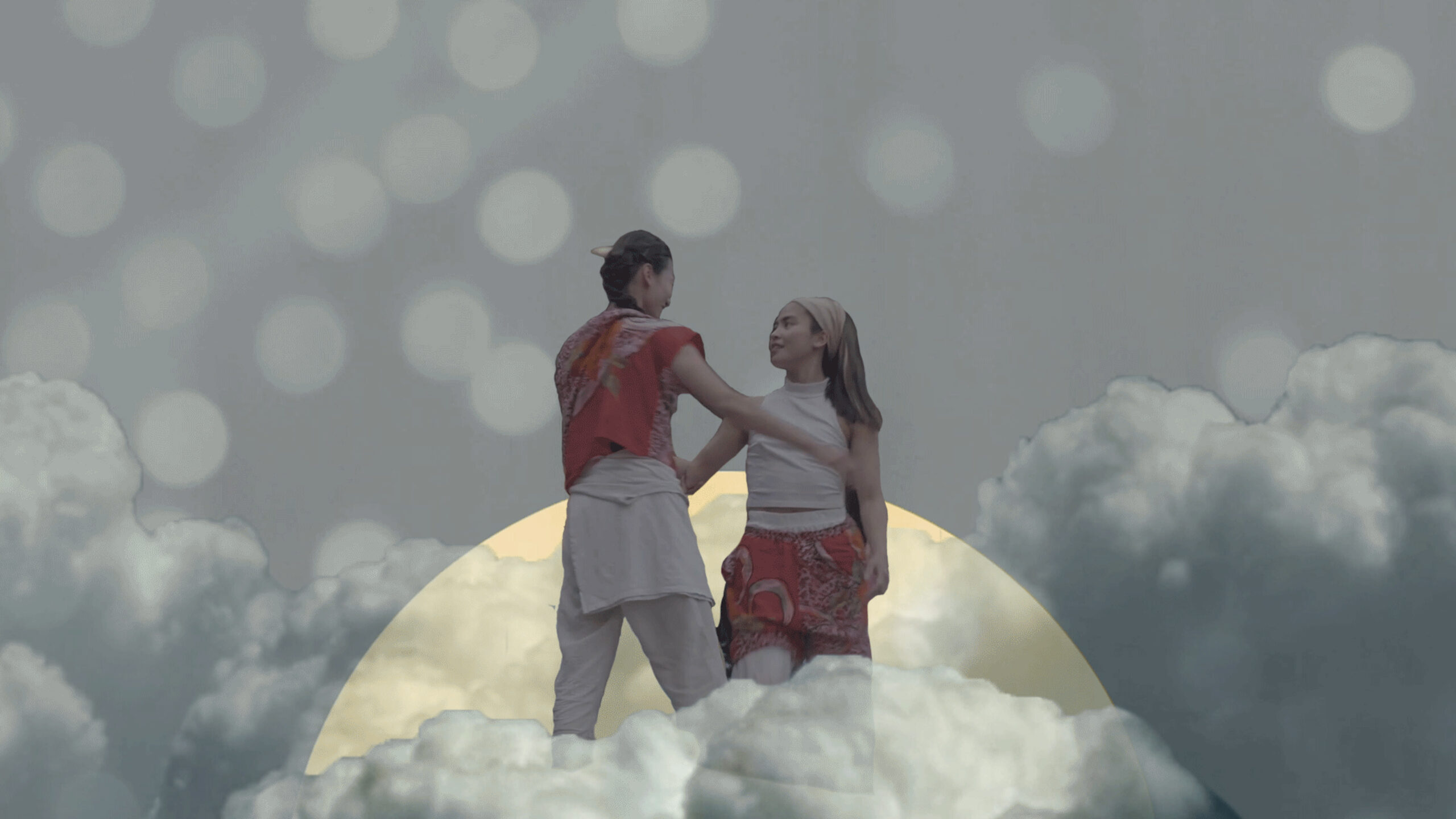
Fire Dancers Animation
Questions about identity begin with the individual, and move outward into race and its constructs, questions about masculinity and about who gets to be American, and through the interconnectedness of New Yorkers going about the quotidian and quiet labor of an artist’s work, a portrait of humanity emerges. What was your approach to capturing that spectrum when choosing participants and how did you think about balancing the political with the deeply personal?
Identity is not a static form, a fixed shape; it’s a dynamic condition we inhabit. It evolves, stretches, contradicts, and becomes through our interactions, our memories, our exposure, and our familiarity. It’s not something we craft from a distance. It works on us, over time, through relation. And the questions it raises — about belonging, about freedom, about who we are allowed to be — are not theoretical. They live in our bodies, in our practices, in how we move through the world.
MEANWHILE was made with people I love, people I’ve been in conversation with for years — sometimes decades. Meshell. Jacquelin. Daniel Alexander Jones. Juli Vanderhoop. Dana Davis.
The film didn’t begin by assembling a cast. It began in community.
It began in trust. These aren’t interviews. These are continuations — of friendships, of artistic dialogues, of shared wondering, shaped over time. The people in the film are artists, yes, but they’re also thinkers, caregivers, visionaries. They’re in the middle of making something — not just a piece of work, but a way of living, of imagining beyond what’s already here.
We filmed across many places — Ohio, California, Massachusetts, New York — and what emerged wasn’t a portrait of place, but a portrait of relation. Of people listening to one another. Showing up. Risking being seen. The political and the personal were never separate — they’re part of the same breath. They shaped each other.
“We’re not always legible to one another… this idea
that something’s sort of hiding in plain sight, or that we can see
one another in lots of different ways — or not see
one another. I’m really interested
in that idea of degrees of not seeing.”
Teresita Fernández
That idea — of degrees of seeing, of allowing space for what can’t be named yet — became central. The film invites a kind of seeing that is slower, more generous, more curious. A seeing that doesn’t close down with certainty, but opens toward connection.
MEANWHILE doesn’t claim to define identity. It holds it in motion. It asks: What can we be, together, when we listen beyond the obvious? When we allow each other to be in process? The film became a kind of shared language — not to simplify who we are, but to stretch what we think is possible.
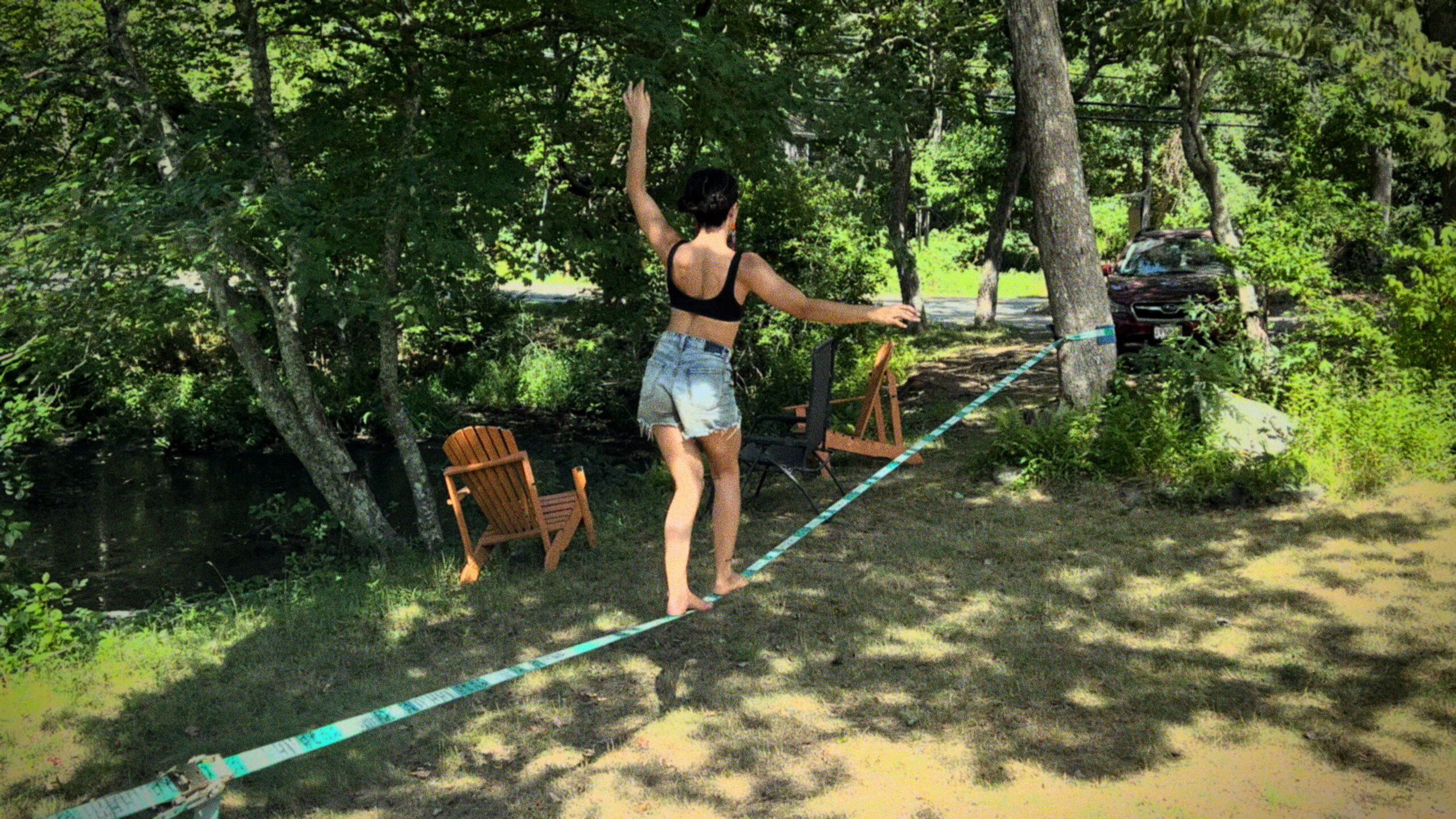
Artist, Ella Mahoney
In the first couple minutes of the film, a participant makes an appeal to empathy (“I see what you see”). It’s interesting because I believe that that is the reach that quite a bit of art makes – the gap between what I see and what you see. After making the film, what do you think art can do in the face of injustice, cruelty, and greed?
I believe there’s no way to survive without art. It shapes how we live inside the world, how we metabolize what it does to us. Art heals, it educates, it dignifies, it can be glorious despite the unbearable, it transforms us. It gives us somewhere to place the weight. The film doesn’t offer answers, it offers presence, a shared space where questions can breathe.
I think of that moment you mention — “I see what you see” — not as a claim to sameness, but a reaching across, through, towards. An opening. In MEANWHILE, that reach is what binds everything – between strangers, collaborators, neighbors, generations. Not agreement, but proximity. Not clarity, but care. That’s what art can do: make space for what doesn’t fit anywhere else or what has been systematically erased, sidelined, omitted. Hidden in plain sight. Art keeps watch. Art will make time for what has been refused. Make beauty without asking permission.
And in the meantime — in the meanwhile — art becomes a site of resistance. But also of tenderness. Of imagination. When the systems we live inside are built on extraction, on forgetting, on violence, art says: still, we breathe. Still, we make. Still, we sing and speak and move. Even here. Especially here.
Art doesn’t end injustice, but it refuses to normalize it. It offers a space
to metabolize, to feel, and to grieve
the violence more deeply. It keeps injustice from calcifying
into silence. It’s not decoration. It’s declaration. A refusal
to disappear. A way of holding on — to memory, to vision, to
each other.
In MEANWHILE, the act of making was a way to stay alive inside a brutal moment. Not to escape it, but to be fully awake to it — and still imagine. Still dream. Still build. Still create something big enough. Something tender, spacious, honest enough to carry us. I think of the dancers in rehearsal, the breathwork, the slowness of Jacqueline’s line landing, “Even in the fire, we can’t extricate ourselves… the blood that moves through our veins sings the same song…” That’s what art can do. It doesn’t look away. It sings in the fire.
I believe art is a space where grief doesn’t collapse
us. Where beauty isn’t naive. Where the imagined is as real
as the inherited. Where we can
say — we are still here. And we are still dreaming.
Rachel Dalamangas
New York, New York
May 2025
Image credits: Abramorama